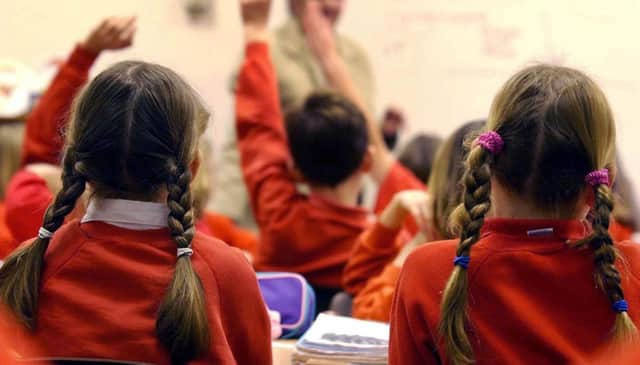Warning over funding shortfall for poor pupils


The pupil premium, which provides extra funding to schools for children from poor backgrounds, was worth £2.5 billion last year but improvements are needed to ensure if offers value for money, the National Audit Office (NAO) said.
The NAO said that inspectors identified “poor provision” for disadvantaged pupils in one-in-five secondary schools between September and December last year.
Advertisement
Hide AdAdvertisement
Hide AdThe watchdog called for a review of the way core school funding was allocated by the Department for Education, because as the money is not allocated on the basis of need some schools saw their funding per child fall despite the introduction of the pupil premium.


The NAO report said: “Over the last four years, the Department has given £6 billion to schools under the pupil premium policy but reduced other school funding in real terms at the same time.
“As a result total per-pupil funding has increased in 55 per cent of schools in real terms, but it has decreased in real terms in the remainder.
“Some schools with very disadvantaged intakes have less money per pupil now, in real terms, than in 2010, despite the extra funding provided by the pupil premium. We estimate that the per-pupil funding of 16 per cent of the most disadvantaged secondary schools fell by more than fiven per cent in real terms between 2010-11 and 2014-15.”
Advertisement
Hide AdAdvertisement
Hide AdThe pupil premium, received by schools for each child eligible for means-tested free school meals, was worth £1,300 for pupils in reception year to Year 6 and £935 for secondary school-age pupils in 2014-15.
Some two million pupils were classed as disadvantaged in 2014 and the funding is aimed at raising their attainment and closing the gap between them and classmates from more affluent backgrounds.
The watchdog said not all disadvantaged children were identified, with the Department’s own estimate indicating that 11 per cent of eligible pupils do not currently receive school meals because their parents do not claim the entitlement.
The attainment gap between disadvantaged and other pupils narrowed by 4.7 percentage points in primary schools and 1.6 percentage points in secondary schools between 2011 and 2014, but no clear trend has been established and the gap remains wide, the NAO said.
Advertisement
Hide AdAdvertisement
Hide AdIn 2014, 63.5 per cent of disadvantaged pupils failed to achieve five good GCSEs including English and Maths, compared with 36 per cent of their peers.
The NAO’s report found that “many schools spend some of the pupil premium on approaches that may not be cost-effective, based on current evidence, reducing the funding’s impact”.
Some 72 per cent of schools provided individual tuition, which is “highly effective but relatively costly”, 63 per cent have sought to improve feedback between teachers and pupils, which is both effective and low cost, the NAO said.
“However, 71 per cent of schools employ extra teaching assistants to support disadvantaged pupils, a high-cost approach which will only improve results if schools learn to deploy these staff more effectively,” the report said.
Advertisement
Hide AdAdvertisement
Hide AdThe NAO estimated that schools’ spending on teaching assistants has increased by £430 million between 2011 and 2013.
School inspector Ofsted reviews the progress of disadvantaged pupils during its visits and found poor provision for disadvantaged pupils in 8% of primary schools and 21 per cent of secondary schools between September and December 2014, the NAO said.
NAO chief Amyas Morse said: “Early signs are that the pupil premium has potential, but it will take time for its full impact to become clear. As it takes the policy forward, the Department will need to review whether spending more in this way would allow it to close the attainment gap more quickly.
“The high degree of local discretion has benefits and costs. Some schools don’t appropriately focus funding on disadvantaged pupils, and some spend funds on activities which are not demonstrably effective.”
Advertisement
Hide AdAdvertisement
Hide AdThe NAO recommended more work to understand how schools are using their pupil premium money and suggested that the DfE should use a “fairer formula” for allocating core funding.
Meg Hillier, the new chairwoman of the Public Accounts Committee, said: “It’s welcome that since the introduction of the pupil premium, head teachers and school leaders are now more focused on improving outcomes for disadvantaged children but it should be a matter of concern that some schools are not spending this funding in a cost effective way.”
The Labour MP added: “Reducing the attainment gap is crucial to tackling poverty. Failure to make the best use of pupil premium funding will mean we fail to invest in children, the future taxpayers of our country.”
A Department for Education spokesman said: “We are determined to ensure that every child, regardless of background, is given an education which allows them to realise their full potential.
Advertisement
Hide AdAdvertisement
Hide Ad“The NAO’s report recognises the important role which the pupil premium has had in improving the educational outcomes, and ultimately life chances of some of the most disadvantaged young people.
“However, we know there is more to be done to tackle educational inequality and we will consider the findings of the NAO report carefully.”